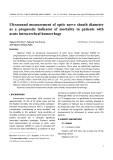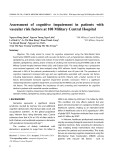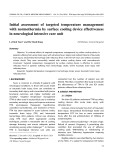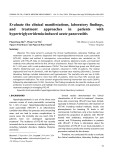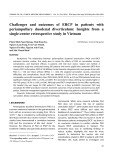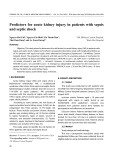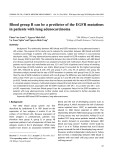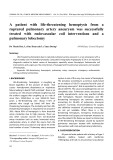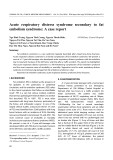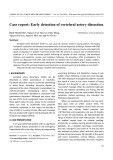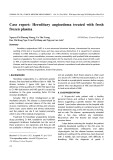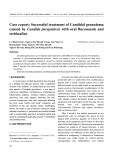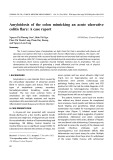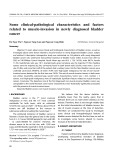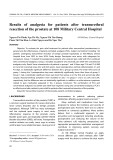doi:10.1046/j.1432-1033.2002.02926.x
Eur. J. Biochem. 269, 2647–2655 (2002) (cid:1) FEBS 2002
Human immunoglobulin A (IgA)-specific ligands from combinatorial engineering of protein A
Jenny Ro¨ nnmark1, Hans Gro¨ nlund2, Mathias Uhle´ n1 and Per-A˚ ke Nygren1 1Department of Biotechnology, Royal Institute of Technology (SCFAB), Stockholm, Sweden; 2Department of Medicine, Unit of Clinical Immunology and Allergy, Karolinska Institute, Sweden
affinity was further analyzed, and showed that human IgA subclasses (IgA1 and IgA2) as well as secretory IgA were recognized with similar efficiencies. No detectable cross- reactivity towards human IgG, IgM, IgD or IgE was observed. The potential use of the ZIgA1 affibody as a ligand in affinity chromatography applications was first demon- strated by selective recovery of IgA protein from a spiked Escherichia coli total cell lysate, using an affinity column containing a divalent head-to-tail ZIgA1 affibody dimer construct as a ligand. In addition, efficient affinity recovery of IgA from unconditioned human plasma was also dem- onstrated.
Keywords: IgA; affibody; combinatorial protein engineering; affinity ligand; phage display. Affinity reagents capable of selective recognition of the dif- ferent human immunoglobulin isotypes are important detection and purification tools in biotechnology. Here we describe the development and characterization of affinity proteins (affibodies) showing selective binding to human IgA. From protein libraries constructed by combinatorial mutagenesis of a 58-amino-acid, three-helix bundle domain derived from the IgG-binding staphylococcal protein A, variants showing IgA binding were selected by using phage display technology and IgA monoclonal antibodies (mye- loma) as target molecules. Characterization of selected clones by biosensor technology showed that five out of eight investigated affibody variants were capable of IgA binding, with dissociation constants (Kd) in the range between 0.5 and 3 lM. One variant (ZIgA1) showing the strongest binding
their hinge region sequences [10]. IgA is predominantly localized to mucosal surfaces but is also present at high levels in plasma [11] and believed to play an important role in defence mechanisms against infections [12]. IgA is also implicated in several diseases including IgA nephropathy [13], coeliac disease [14], Henoch-Scho¨ nlein purpura [15] and neurological diseases [16], where IgA levels are mon- itored as a disease marker or investigated for a more direct involvement in disease progression. Interestingly, recent data suggest that IgA should be an interesting isotype to validate for development of antibodies for immunotherapy applications, including cancer therapy, due to its effective recruitment of neutrophils [17].
Efficient and selective methods for immunoglobulin (Ig) detection and purification are of major importance for a vast number of applications within areas such as immuno- logy, diagnostics and biotechnology. For these purposes, an often recruited class of reagents is derived from so-called receptin proteins, produced as surface-anchored or soluble proteins by some bacteria [1]. Many of these proteins show binding to one or more mammalian serum or cell surface proteins, including for example Ig, serum albumin and fibrinogen [1]. One of the most well-known Ig-binding receptins is staphylococcal protein A, widely used in many formats for its capability to bind a wide spectrum of Igs via Fc or VH region recognition [2–5]. Other examples of frequently used Ig-binding receptins include streptococcal protein G [6,7] and Peptostreptococcus magnus protein L [8,9]. The binding specificities displayed by different Ig-binding receptins differ significantly in terms of Ig isotype, subclass, species origin and subfragment type (Fc, Fab, scFv, etc.), which makes the choice of reagent for a particular application important.
IgA is the most abundant Ig isotype in humans where it is present in two subclasses, IgA1 and IgA2, differing mainly in
Correspondence to P.-A˚ . Nygren, Department Biotechnology, Royal Institute of Technology, SCFAB, SE-106 91 Stockholm, Sweden. Fax: + 46 855378481, Tel.: + 46 855378328, E-mail: perake@biotech.kth.se Abbreviations: c.f.u., colony forming units; Kd, dissociation constant; ABD, albumin binding domain; HSA, human serum albumin; NHP, normal human plasma; CIC, circulating immune complexes. (Received 31 January 2002, revised 5 April 2002, accepted 10 April 2002)
The identification of receptins or the development of other classes of ligands capable of selective IgA binding will therefore be important for biotechnology tools, facilitating IgA recovery and detection. Interestingly, receptin proteins shown to be capable of IgA binding have been described, including the Sir22 and Arp4 proteins isolated from Streptococcus pyogenes [18,19]. These proteins were recently shown to bind both IgA1 and IgA2 and mapped to recognize the CH2–CH3 interface on the IgA Fc fragment. The biotechnological use of this class of proteins has been recognized and initially investigated for immunodetection applications using the IgA binding protein B from group B streptococci [20].
In this work, we describe an alternative approach to obtain novel IgA binding ligands, using combinatorial protein engineering to change the binding specificity of an already existing receptin protein. Employing a 58-amino- acid domain derived from one of the immunoglobulin binding (IgG) domains of staphylococcal protein A as a scaffold, we have previously described the construction of
(cid:1) FEBS 2002
2648 J. Ro¨ nnmark et al. (Eur. J. Biochem. 269)
for Zlib-1 and Zlib-2, respectively, from a serial dilution of phages allowed to infect E. coli and plated on agar plates containing ampicillin (100 lgÆmL)1).
Selections
ester acid N-hydroxysuccinimide
combinatorial protein libraries from which novel affinity proteins (denoted Z-affibodies) have been selected for binding to desired target proteins using phage display technology [21,22]. In common with their protein A ancestor, several of the described affibodies have been shown to be useful as selective and robust ligands in affinity chromatography applications [23–25]. Here, we describe the use of the affibody technology platform for the identifica- tion of protein A-derived variants showing IgA- rather than IgG-binding, thus expanding the available repertoire of tools for detection and recovery of native or recombinant IgA from different sources. The selection procedure, biosensor binding affinity and specificity data of candidate ligands as well as the affinity chromatographic recovery of IgA from a bacterial lysate and unconditioned human plasma is described.
M A T E R I A L S A N D M E T H O D S
Strains and vectors
E. coli strain RR1DM15 (supE) [26] was used as host for the phage production and cloning work. For protein expres- sion, strains RRIDM15 or the nonsuppressor E. coli strain RV308 [27] were used, as indicated. The phagemid vector pKN1 has been described previously [21,22]. Phage stocks were prepared using M13K07 helper phage (New England Biolabs).
Affibody phage display libraries
The construction of the Z-affibody phage libraries Zlib-1 and Zlib-2 has been described previously [21,22]. The two libraries differ in the use of degeneracy for variegated codons, where NN(G/T) and (C/A/G)NN codons were used for Zlib-1 and Zlib-2, respectively. Both libraries have sizes of (cid:1) 4.5 · 107 members.
Phage stocks
Two different human myeloma IgA1 antibody prepara- tions, denoted IgA1116 and IgA2167 (kind gifts from Pharmacia Diagnostics AB, Sweden), were used as panning targets during selections. The IgA antibodies were sepa- rately biotinylated in vitro using a D-biotinoyl-e-amidocap- roic (Boehringer Mannheim GmbH, Germany), according to the supplier’s recommendations. Biotinylated antibodies were bound to streptavidin-coated paramagnetic Dynabeads(cid:4) (SA-beads) (Dynal AS, Norway) at conditions resulting in (cid:1) 30 lg IgA per mg beads. In each selection cycle, approximately 1010)1011 phages were mixed with 5 mg target-containing beads in a total volume of 100 lL, resulting in a final IgA concentration during selection of approximately 10 lM. Prior to selection, IgA-containing beads were incubated with 0.1% gelatine for 30–60 min Prior incubation with IgA-coated beads phage stocks were incubated with clean SA-beads (cycles two to five). The two IgA1 antibodies targets during selections were used alternatively as (IgA2167: cycles 1, 2 and 4; IgA1116: cycles 3 and 5). Phage stocks were incubated with target-containing beads for 2–4 h, after which the beads were washed with portions of 500 lL of NaCl/Pi buffer according to the following. Cycle 1: two washes (10 min); cycles 2–4: six washes (25 min); cycle 5: 10 washes (27 min). Bound phages were released with 500 lL of 0.1 M glycin/HCl pH 2.2 for 10 min and the supernatant was neutralized in 50 lL 1 M Tris/HCl pH 8.5. All steps were performed at room temperature (20–22 (cid:3)C) and all tubes were preblocked with NaCl/Pi supplemented with 0.1% gelatine. The two eluates originating from separate use of the Zlib-1 and Zlib- 2 libraries in the first cycle were mixed and treated as one library in the following cycles. The selection process was monitored by titrating the phage stocks before selection and after elution as described above.
DNA sequencing
Randomly picked colonies after infection with the cycle five eluate were subjected to PCR amplification of inserts for solid phase DNA sequencing using an ALFexpressTM sequencing instrument (Amersham Biosciences, Sweden), as described previously [21]. Other constructs were sequenced by cycle sequencing DNA methodology on a MegaBACETM 1000 instrument (Amersham Biosciences) using BigDye Terminators (PerkinElmer Applied Biosys- tems, USA).
Production and purification of proteins from phagemid constructs
The phage stocks were prepared as follows. Cells hosting the respective phagemid library were cultivated in shake flasks containing 50 mL tryptic soy broth supplemented with yeast extract (TSB+YE) and ampicillin (100 lgÆmL)1) at 37 (cid:3)C to D600 ¼ 0.5. An aliquot (10 mL) was incubated with 1011 colony forming units (c.f.u.) of M13K07 helper phage for 30 min at 37 (cid:3)C followed by centrifugation at 2500 g for 10 min The cells were resuspended and trans- ferred to 100 mL TSB+YE with ampicillin (100 lgÆmL)1), kanamycin (25 lgÆmL)1) and isopropyl thio-b-D-galacto- side (100 lM) and cultivated overnight ((cid:1) 20 h) at 30 (cid:3)C. The supernatant of the overnight culture was subjected to poly(ethylene glycol) precipitation: 25 mL poly(ethylene glycol)/NaCl [20% poly(ethylene glycol) 6000, 2.5 M NaCl] was added and the mixture was incubated on ice for (cid:1) 60 min at 4 (cid:3)C. After centrifugation at 10 400 g for 30 min, the pellet was resuspended in 15 mL distilled water and another 2.75 mL poly(ethylene glycol)/NaCl was added for a second precipitation on ice for 30 min at 4 (cid:3)C followed by centrifugation at 16 300 g for 30 min. Finally, the pellet was resuspended in NaCl/Pi (50 mM phosphate, 100 mM NaCl, pH 7.2) and filtered (0.45 lm). The phage library titers were calculated to 1 · 1011 and 1 · 1012 c.f.u. per mL Sequenced clones were expressed as periplasmically secreted affibody-ABD fusion proteins in the nonsuppressor E. coli strain, RV308. From an overnight culture in the same medium, 1 mL was inoculated to 100 mL TSB+YE supplemented with ampicillin (100 lgÆmL)1) and cultivated at 37 (cid:3)C to a D600 of (cid:1) 1. This culture was induced by
IgA-specific affibody ligands (Eur. J. Biochem. 269) 2649
(cid:1) FEBS 2002
Construction and production of dimeric (head-to-tail) affibody constructs
adding isopropyl thio-b-D-galactoside to a final concentra- tion of 1 mM and cultivated at room temperature overnight. The periplasmic fraction was collected by an osmotic shock procedure and the clones were purified by affinity chroma- tography on human serum albumin Sepharose column as follows: the column was pulsed with 0.5 M HAc, pH 2.8 and TST (25 mM Tris/HCl, 200 mM NaCl, 1.25 mM EDTA, 0.05% Tween 20, pH 8.0), respectively, and equilibrated with TST before loading the sample. After washing with TST, pH was lowered by adding 5 mM NH4Ac (pH 5.5) and the protein was eluted with 0.5 M HAc, pH 2.8. Relevant fractions were lyophilized, separated on a homo- genous 20% SDS/PAGE PhastGelTM (Amersham Bio- sciences) and stained with Coomassie Brilliant Blue.
The gene fragment encoding the ZIgA1 affibody was amplified from a pKN1-ZIgA1 phagemid template by PCR using primers NOKA-6 and NOKA-7 [29]. The resulting PCR product was cleaved with SalI and XhoI and ligated into the XhoI site (in front of the ABD tag) of the phagemid pKN1-ZIgA1. The resulting construct denoted pKN1-dZIgA1 thus encodes a dimeric (head-to-tail) (ZIgA1)2-ABD affibody construct. This construct was subsequently further modified through the insertion of a linker sequence formed by the oligonucleotides ZlibHisStop-1: 5¢-TCGACCCATCAT CATCATCATCATTAATAAGTCGAC-3¢ and ZlibHis- Stop-2: 5¢-TCGACGTCGACTTATTAATGATGATGA TGATGATGATGGG-3¢ encoding a hexahistidyl sequence followed by a stop codon into the XhoI site (in front of the ABD tag), resulting in phagemid pKN1-dZIgA1-His6 enco- ding a dimeric (head-to-tail) (ZIgA1)2-His6 affibody con- struct. The (ZIgA1)2-ABD affibody fusion protein encoded by phagemid pKN1-dZIgA1 was produced in strain RV308 and purified as described above. The (ZIgA1)2-His6 affibody fusion protein was produced in strain RR1DM15 under the same conditions as above and purified from the periplasm by immobilized metal ion affinity chromatography (IMAC) using 2 mL TALONTM (Co2+) media (Clontech Laborat- ories Inc., CA, USA). After a standard osmotic shock procedure, the periplasmic fraction was dissolved in load- ing/running buffer (50 mM NaH2PO4, 10 mM Tris/HCl, 100 mM NaCl, pH 8.0) and loaded on the TALONTM column, pre-equilibrated with 20 mL running buffer. The column was washed with 30 mL running buffer and the protein was released with 10 · 1 mL elution buffer (50 mM NaH2PO4,100 mM HAc, 100 mM NaCl, pH 5.0). Fractions 3–10 were desalted on a PDTM-10 column (Amersham Biosciences) with a simultanous buffer change to 5 mM NH4Ac pH 5.5, lyophilized and than analysed on a homogenous 20% SDS/PAGE PhastGelTM (Amersham Biosciences) stained with Coomas- sie Brilliant Blue.
Ligand immobilization and affinity chromatography
Biosensor analyses A BiacoreTM 2000 (Biacore, Sweden) was used for the biospecific molecular interaction studies between selected affibodies and IgA2167. As running buffer, HBS (10 mM Hepes, 150 mM NaCl, 3.4 mM EDTA, 0.005% Surfactant 20, pH 7.4) was used at a flow rate of 5 lLÆmin)1 in all experiments. Between injections, the surfaces were regene- rated with 10 mM HCl and/or 0.05% SDS. Proteins were immobilized on CM5 chip surfaces (Biacore) using amine coupling chemistry according to the manufacturer’s recommendations. At one chip, (cid:1) 3400 RU (response units) of HSA and 5300 RU of IgA2167 were immobilized in different flow cells. Initial analyses of selected variants were performed using the HSA surface by injection of 25 lL (25–70 lM) protein dissolved in HBS, directly followed by injection of 25 lL IgA2167 (2 lM) in HBS. The IgA2167 surface was used for binding affinity studies through steady state response value analyses for different concentrations of injected analyte employing BIAEVALUA- TION 3.0 software (Biacore). The program fits the data to the formula Ka ¼ Req/(Rmax ) Req) where Req is the equilibrium response at a given concentration of analyte. )1) and Rmax the Ka ( ¼ 1/Kd) is the affinity constant (M response at saturation. Three affibody variants were investigated with random injection (duplicate samples) of 25 lL protein with concentrations ranging from 40 nM to 140 lM. Regeneration was performed with 5 lL 0.05% SDS.
recombinant
One chip was prepared with ZIgA1-ABD protein (720 RU), Zwt-ABD protein (640 RU) and ABD protein (reference, 380 RU), immobilized in different flow cells for initial IgG/IgA binding specificity studies and the same chip was also used for subsequent human isotype and subclass specificity analyses. 35 lL samples (0.2 lM) of human polyclonal IgA (Sigma–Aldrich Chemie, Germany, cat. no I-1010), human polyclonal IgA1 (Calbiochem, USA, cat. no. 400105), human myeloma IgA2 (Calbiochem, cat. no. 400110), human myeloma IgM (Pharmacia Diagnos- tics), human polyclonal IgG (Pharmacia, Sweden), human myeloma IgD (Chemicon, USA, art. no AG740), secretory IgA (Nordic Immunological Laboratories, Netherlands, IgE cat. no P020) and a monoclonal mouse::human chimera consisting of murine light chain and VH domains and human epsilon 1–4 heavy chain domains [28] were separately injected and the responses recorded. The reference surface (ABD) was used to produce subtractive sensorgrams. The (ZIgA1)2-ABD or (ZIgA1)2-His6 affibody fusion proteins (2.5 mg and 2 mg, respectively), were immobilized onto 1 mL HiTrap NHS-activated SepharoseTM High Perform- ance columns (Amersham Biosciences), according to the manufacturer’s recommendations. To provide a complex background for affinity chromatography experiments, 100 mL of an overnight culture of E. coli, strain RR1DM15, was pelleted by centrifugation, redissolved in 10 mL 1 · TST buffer and lysed by sonication. One milliliter of the lysate into which 0.1 mg of the IgA1116 antibody had been previously added was loaded onto the (ZIgA1)2-ABD column. After washing with 1 · TST protein was eluted of the column by adding 0.5 M HAc pH 3.2. Applied sample, flow-through and eluted proteins were analysed by SDS/ PAGE on a 10–15% PhastGelTM under reducing conditions (Amersham Biosciences) and stained by Coomassie Brilliant Blue. The eluate was also analyzed under nonreducing conditions. One milliliter of unconditioned normal human plasma (NHP) was applied onto the (ZIgA1)2-His6 column at 25 (cid:3)C and after washing with 10 mL phosphate buffer
(cid:1) FEBS 2002
2650 J. Ro¨ nnmark et al. (Eur. J. Biochem. 269)
pH 7.5 and 2 mL of 5 mM NH4Ac, pH 5.5, the column was eluted with 0.5 M HAc pH 3.0. Applied sample, flow- through and eluted proteins were analysed by SDS/PAGE on a 10–20% Novex(cid:4) gel (Invitrogen life technologies, UK) and stained by Coomassie Brilliant Blue. Sample, flow- through, wash fractions and eluted proteins were further analysed for IgA, IgG and IgM content by immunoprecip- itation (nephlometry) at the routine laboratory at the Karolinska Hospital, Stockholm, Sweden, using a Swedac accredited IMMAGE instrument (Beckman Coulter, Stock- holm, Sweden). The detection limits for IgG, IgM and IgA assays were 0.33, 0.04 and 0.02 gÆL)1, respectively.
Western blotting
Sample, flow-through and eluate fractions from the affinity chromatography experiment with unconditioned NHP were applied on a 10–20% SDS/PAGE gel (Novex(cid:4)) and proteins were electroblotted to nitro-cellulose membranes (Novex(cid:4)). The blotted membranes were preblocked in blocking solution (1% milk powder in TST) for 30 min at room temperature and washed twice with TST. The membranes were then incubated for 1 h at room tempera- ture with horse radish peroxidase (HRP)-conjugated IgG rabbit polyclonal antibodies directed to either human IgA, IgG, IgM, IgD or IgE (all from Serotec, UK) diluted 1 : 1000 (IgA), 1 : 3000 (IgG), 1 : 500 (IgM), 1 : 500 (IgD) and 1 : 500 (IgE) in 0.15 M NaCl, 50 mM Tris/HCl, pH 7.5. After washing of the membranes four times in TST for 15 min, staining was performed for (cid:1) 20 min with a solution of 0.15 M NaCl, 50 mM Tris/HCl, pH 7.5 supple- mented with 0.1% H2O2 and a small amount of 3,3¢- dinitrobenzidine (Sigma–Aldrich).
R E S U L T S
Fig. 1. Schematic representation of the location of positions for rando- mization and their amino-acid occupancies in selected variants. (A) Ribbon diagram of the three-helix bundle wild type Z domain (PDB file 1SPZ), with the 13 positions randomized during affibody library constructions indicated (labeled green and numbers. (B) Deduced amino-acid occupancies at the variegated 13 positions in the investi- gated affibody variants selected for human IgA binding in this work. +/–, confirmed IgA binding or not in biosensor studies (see text for details).
Selection and production of affibody variants
Biosensor analyses
To investigate if any of the eight candidate affibody variants showed IgA binding, a biosensor binding study was performed. Affibody–ABD fusion proteins (25–70 lM) were separately injected over a HSA-coated sensor chip surface for indirect immobilization via their C-terminal ABD fusion partners, followed by an immediate injection of a solution containing one of the IgA1 monoclonals used as panning target. From the resulting overlay sensorgram it can be seen that five of the eight variants showed significant IgA interaction, of which three variants (ZIgA1, ZIgA2 and ZIgA3) showed higher responses (Fig. 2). Interestingly, these vari- ants contained identical substitutions at five of the 13 randomized positions (positions 13, 17, 27, 28 and 35) with additional surrounding similarities, indicating a hypothet- ical consensus motif.
A phage displayed protein library constructed by combina- torial mutagenesis of surface-located positions of the IgG- binding domain Z was used as source for the identification of variants (affibodies) capable of selective binding to human IgA. In order to direct the selection of IgA binding affibody variants towards nonvariable domains, two differ- ent human IgA1 monoclonal antibodies (myelomas) were used alternatively as microbead-immobilized panning tar- gets during five cycles of affibody phage library selection. To increase the selection stringency, increasing number of washing steps were introduced in later cycles. DNA sequence analyses were performed on 10 clones derived from the fifth cycle eluate, which revealed two clones that were represented twice (ZIgA7 and ZIgA4) and an additional six unique variants. An alignment of their amino-acid sequences showed upon regions of similarities between some variants (Fig. 1; see Discussion), although no obvious overall consensus sequence could be identified. For subse- quent binding analyses, all eight variants were produced from their respective phagemid vectors as fusions to a 5-kDa albumin binding domain (ABD) affinity tag, facili- tating their recovery from periplasmic fractions by HSA- affinity chromatography. Expression levels for all eight affibody-ABD fusions were in the 10–20 mgÆmL)1 culture range. Interestingly, the ZIgA7 variant, represented twice among the sequenced clones, did not show any IgA binding under these conditions. The three variants showing the highest binding responses were chosen for further binding studies in
IgA-specific affibody ligands (Eur. J. Biochem. 269) 2651
(cid:1) FEBS 2002
1900
A
3200
IgA injected
ZIgA1
1700
2800
3
)
2400
1500
U R
ZIgA1 surface
ZIgA2
2000
1300
1600
]
ZIgA3 ZIgA4
1100
U R
1200
ZIgA5
900
2
800
1
( s t i n u e s n o p s e R
400
700
[ s t i n u e s n o p s e R
ZIgA6
0
ZIgA7
500
ZIgA8
-400
300
0
100
200
300
400
500
600
700
800
900
1000
Time (s)
100
Zwt surface
-100
0
200
400
600
800
1000
1200
1400
Time [s]
1900
B
IgG injected
1700
1500
Zwt surface
Fig. 2. Overlay sensorgram from IgA binding studies of eight affibody- ABD fusion proteins. Samples were injected over a HSA-coated surface for an initial directed immobilization via the ABD tag–HSA inter- action (1), directly followed by injections of a 2-lM solution of human IgA1 (myeloma) (2), ending at (3). Five variants, denoted ZIgA1-ZIgA5 were confirmed to bind human IgA under these conditions.
1300
]
1100
U R
900
700
which their IgA binding affinities (Kd) were determined to 0.5–3 lM, with the highest affinity observed for the ZIgA1 variant which was chosen for further studies.
[ s t i n u e s n o p s e R
500
300
ZIgA1 surface
100
-100
0
200
400
600
800
1000
1200
1400
Time [s]
Fig. 3. Initial binding specificity analysis of the ZIgA1 variant. Resulting overlay sensorgrams from injections of human IgA (A) or human polyclonal IgG (B) over separate sensor chip surfaces containing either ZIgA1–ABD or Zwt–ABD proteins, as indicated.
2400
1900
The binding specifity of the ZIgA1 variant was further analyzed in a series of biosensor binding studies. To investigate if the IgA binding capability of the ZIgA1 affibody could possibly be explained by any IgA binding activity present already in the Z domain scaffold used for library constructions, Zwt–ABD and ZIgA1–ABD fusion proteins were analyzed in parallel as immobilized onto sensorchip surfaces for their IgA and IgG binding capabil- ities. The results from this analysis showed that the wild- type Z domain did not possess any IgA binding activity, and that the selected ZIgA1 affibody had not retained any detectable IgG binding ability from its ancestral Z domain structure (Fig. 3). The isotype binding selectivity of the ZIgA1 affibody was further challenged with injections of human IgM, IgD or IgE antibody preparations. No detectable binding to these isotypes could be observed under these conditions (Fig. 4).
pIgA
sIgA
]
1400
U R
IgA1
IgA2
900
[ s t i n u e s n o p s e R
IgM
400
pIgG
IgD
IgE
-100
0
200
400
600
800
1000
1200
1400
Time [s]
Fig. 4. Isotype specificity analysis of the ZIgA1 affibody. Resulting overlay sensorgrams from separate injections of 0.2 lM solutions of human polyclonal IgA and IgA1, human myeloma IgA2 and IgM, human secretory IgA, human polyclonal IgG, human myeloma IgD or recombinant mouse (light chain and VH)::human (epsilon 1–4 heavy chain) chimera, respectively, over a sensor chip surface containing coupled ZIgA1–ABD protein.
In the selection of the ZIgA1 affibody, two human IgA1 monoclonal antibodies were used as panning targets. To investigate if antibodies belonging to the human IgA2 subclass also were recognized by the ZIgA1 affibody, human polyclonal IgA1 and human myeloma IgA2 samples were analyzed for binding. The results showed that the ZIgA1 affibody was indeed capable of binding to both IgA1 and IgA2 (Fig. 4). In addition, human polyclonal IgA, contain- ing both subclasses, was also efficiently bound by the ZIgA1 affibody (Fig. 4). Binding was also demonstrated to secre- tory IgA, composed of dimeric IgA linked by the J-chain and secretory component (Fig. 4). Taken together, the binding specificity studies suggested that the ZIgA1 affibody recognized an IgA-specific epitope present in all known forms of human IgA.
Affinity recovery of IgA from a spiked E.colitotal lysate
head-to-tail dimer of the ZIgA1 ligand fused to the serum- albumin-binding ABD tag, to activated Sepharose using amine coupling chemistry (see Materials and methods, and To investigate the potential use of the ZIgA1 affibody as an IgA-specific ligand in affinity chromatography applications, an affinity column was prepared by coupling of (ZIgA1)2– ABD fusion protein, consisting of a genetically constructed
(cid:1) FEBS 2002
2652 J. Ro¨ nnmark et al. (Eur. J. Biochem. 269)
IgA protein was the ligand, monoclonal
prepared through coupling of an alternative dimeric ligand devoid of the albumin binding ABD tag [denoted (ZIgA1)2- His6] to activated Sepharose media (see Materials and methods) and coupled to a chromatographic system. One milliliter of human plasma sample was applied and samples from the flow through, wash and eluate (low pH) fractions were collected for later analyses. A chromatogram (A280) from a typical experiment is shown in Fig. 6, with a large flow-through peak, followed by base-line values during washing and a significant eluate peak. Nephlometry analy- ses for IgG, IgM and IgA in the different fractions showed that IgG and IgM were present in the flow-through and early wash fractions, but not in the eluate. In contrast, IgA could not be detected in the flow-through but was present at high concentration in the eluate, indicating an efficient and selective capture of IgA.
Discussion). This dimerization did not change the isotype binding specificity of the IgA affibody ligand, as determined by biosensor technology (data not shown). To provide a complex background of proteins for testing of the selectivity of spiked (0.1 mgÆmL)1) into an E. coli total lysate obtained by sonication of a stationary phase bacterial culture. After sample loading and subsequent washing, the column was eluted with low pH. Analysis by SDS/PAGE (reducing conditions) of the flow-through and eluate fractions showed that the IgA material had been efficiently recovered with high purity (Fig. 5). Analysis by nonreducing SDS/PAGE showed that the eluate contained a band of high molecular mass but no material migrating as separate heavy and light chains, indicating that intact IgA had been recovered (data not shown). This showed that the micromolar affinity of the interaction was sufficient for affinity chromatography and that the selectivity of the ligand was high.
Affinity recovery of IgA from human plasma
The potential use of the ZIgA1 affibody as affinity ligand for selective chromatographic recovery of IgA directly from human blood fractions was also investigated. In this experiment unconditioned normal human plasma was used as the source of IgA, containing in addition to IgA also all other antibody isotypes and a highly complex mixture of other proteins [30]. For this experiment, due to the presence of serum albumin in plasma, an affinity column was
An SDS/PAGE analysis of the sample, flow-through and eluate fractions showed that the recovered IgA had been efficiently purified (Fig. 7A). For a more sensitive analysis than provided by the nephlometry method, the efficiency of the procedure and the purity of the recovered IgA was further tested by immunoblotting on the same fractions with reagents specific for human IgA, IgG, IgM and IgD isotypes (Fig. 7B–E). As expected, all four isotypes could be detected in the applied sample. For the flow-through fractions, similar staining intensities as in the sample fractions were observed for IgG, IgM and IgD, indicating that these isotypes were not significantly retarted in the column. Interestingly, IgA could not be detected in the flow-through fraction, supporting the notion that this isotype had been efficiently recovered from the plasma sample. The analyses of the eluate fraction showed upon a major IgA content as expected, but with small amounts of contaminating IgG and IgM (see below).
D I S C U S S I O N
In this work, a combinatorial protein engineering approach was used to obtain novel IgA binding proteins. Using the well-characterized protein A-derived IgG-binding, three- helix bundle domain Z as scaffold for library constructions,
Sample
PBS
Acetic acid
NH4Ac
]
U A m
[ 0 8 2 A
4200 4000 3800 3600 3400 3200 3000 2800 2600 2400 2200 2000 1800 1600 1400 1200 1000 800 600 400 200 0 -200
0
10 11 12 13 14 15 16 17 18
1
2
3
4
5
6
7
8
9
1 2 3 4 5 6 7 8 9 10 11 12 13 14 15 16 17 18
Fraction
Fig. 5. SDS/PAGE analysis (reduced conditions, Coomassie Brilliant Blue staining) of different samples from the recovery of IgA protein from a spiked E. coli total lysate. Lane 1, applied sample; lane 2, flow- through fraction and lane 3, eluate fraction. The reducing conditions results in the separation of the IgA into heavy and light chain frag- ments.
Fig. 6. Chromatogram from the affinity chromatography purification of IgA from unconditioned normal human plasma using an affinity column containing a divalent (ZIgA1)2-His6 ligand. Intervals for sample loading, NaCl/Pi buffer washing, ammonium actetate buffer washing and low pH elution are indicated. The A280 was monitored throughout the experiment.
IgA-specific affibody ligands (Eur. J. Biochem. 269) 2653
(cid:1) FEBS 2002
Fig. 7. SDS/PAGE (reduced conditions, Coomassie Brilliant Blue staining) of sample (S), flow-through (FT) and eluate (E) samples from the affinity chromatography experiment shown in Fig. 6 (A), and corresponding human isotype-specific Western blotting analyses of the same samples (B–E). For the isotype analysis different human isotype-specific horse radish-conjugated rabbit IgG sera were used as follows: anti-(human IgA) Ig (B), anti- (human IgG) Ig (C), anti-(human IgM) (D) and anti-(human IgD) Ig (E).
obvious biological selection pressure, suggesting that more or less any site on the IgA heavy chain not protected by the secretory component could contain the binding epitope. The recognition of both the IgA1 and IgA2 subclasses suggests that the IgA hinge region, which differs in length and sequence between the two forms of IgA, is not significantly involved in the binding.
five out of eight investigated variants selected using phage display technology showed IgA binding. The reasons leading to the selection of non-IgA binding variants were not investigated further, but could be due to background binding of such variants to components other than IgA present during selection, such as streptavidin beads and phages. In several of the confirmed binders, some substitu- tions were identical with a preference to the second variegated helix (Fig. 1). This could indicate that these variants binds to a common site on the IgA protein.
In the affinity chromatography experiments, head-to-tail dimeric constructs of the ZIgA1 affibody were used, resulting in divalent ligands. Although the primary reason for the dimerization was to increase the likelihood that at least one moiety in each dimeric ligand was biologically active after the amine coupling procedure, a divalent capturing ligand could potentially also result in adventageous avidity effects in the binding between the ligand and the target as well as to provide a beneficial effect on the presentation of the immobilized ligand to the surrounding solution related to the use of a larger ligand (spacer effect).
One of the confirmed IgA-binders (clone ZIgA1) was characterized further and showed to be selective for human IgA in a series of biosensor binding studies, where the specificity was challenged with all other human isotypes, including polyclonal IgG. Further studies showed that both IgA1 and IgA2 subclasses, as well as secretory IgA, was efficiently recognized by the ZIgA1 variant. In comparison to three described natural bacterial IgA binding proteins, this gives the ZIgA1 affibody an IgA binding profile closer to those of the Arp4 and Sir22 proteins from Streptococcus pyogenes than that of the serologically distinct IgA-binding receptins from group B streptococci, showing only weak binding to secretory IgA [31]. However, no obvious sequence similarity can be seen between the ZIgA1 affibody sequence and a 29-residue motif that shows sequence similarity between the Arp4 and Sir22 proteins and has been postulated to contain the IgA binding regions in these proteins. Interestingly, a 50-residue peptide derived from Sir22 containing this motif as central element was found to bind IgA with high specificity [18], but was described to be dependent on the formation of coiled-coiled dimers for IgA binding.
The efficient recovery of IgA from the unconditioned human plasma suggests that the described ligand could be of interest to evaluate for use in extracorporeal IgA-removal applications, of potential relevance for investigation and treatment of IgA nephropathy. Interestingly, whereas the biosensor binding data showed that the ZIgA1 affibody was highly selective for IgA, small amounts of IgM and IgG could be detected by Western blotting in the eluate from the recovery of IgA from human plasma. This could possibly be explained by the presence of natural immunoglobulin- specific autoantibodies in healthy individuals, resulting in the formation of circulating immune complexes (CIC). Such natural autoantibodies have been described to be of IgM, IgG and IgA isotypes [33]. In addition, anti-(protein A) Ig, recognizing the nonvariegated parts of protein A-derived affibody ligand structure, could also be present in the plasma, as a result of previous bacterial infections of the plasma donors.
A growing number of antibodies intended for thera- peutic use are currently under investigation in clinical trials [34]. The majority of those are of IgG isotype, which can effectively activate complement- and antibody- dependent cellular cytotoxicity pathways. In addition, The binding sites for the three natural streptococcal IgA binding receptins were recently mapped to the CH2–CH3 region interface of the Fc fragment, overlapping with the binding site for the human CD89 IgA receptor [19], suggesting biological significance. It is worth noting that in the interactions between IgG and protein A or protein G, the corresponding domain interface is involved in the binding [32]. However, the IgA binding proteins described in this work were selected in vitro, in the absence of any
(cid:1) FEBS 2002
2654 J. Ro¨ nnmark et al. (Eur. J. Biochem. 269)
12. Lamm, M.E. (1997) Interaction of antigens and antibodies at
mucosal surfaces. Annu. Rev. Microbiol. 51, 311–340.
13. Feehally, J. & Allen, A.C. (1999) Pathogenesis of IgA nephro-
pathy. Ann. Med. Internatl 150, 91–98.
14. Lindqvist, U., Rudsander, A., Bostrom, A., Nilsson, B. & Michaelsson, G. (2002) IgA antibodies to gliadin and coeliac disease in psoriatic arthritis. Rheumatology 41, 31–37.
15. Saulsbury, F.T. (2001) Henoch-Scho¨ nlein purpura. Curr. Opin.
Rheumatol. 13, 35–40.
16. Leary, S.M., McLean, B.N. & Thompson, E.J. (2000) Local synthesis of IgA in the cerebrospinal fluid of patients with neurological diseases. J. Neurol. 247, 609–615.
17. Dechant, M. & Valerius, T. (2001) IgA antibodies for cancer
therapy. Crit. Rev. Oncol. Hematol. 39, 69–77.
18. Johnsson, E., Areschoug, T., Mestecky, J. & Lindahl, G. (1999) An IgA-binding peptide derived from a streptococcal surface protein. J. Biol. Chem. 274, 14521–14524.
19. Pleass, R.J., Areschoug, T., Lindahl, G. & Woof, J.M. (2001) Streptococcal IgA-binding proteins bind in the Ca2-Ca3 inter- domain region and inhibit binding of IgA to human CD89. J. Biol. Chem. 276, 8197–8204.
antibodies of the IgG isotype are effectively purified by protein A affinity chromatography, which is also imple- mented at industrial scale processes [35]. However, the IgA isotype has also been suggested for immunotherapy applications, owing its strong association with neutrophils and the possibility to direct antibodies to luminal surfaces [17]. For example, Streptococcus mutans-specific IgA has been investigated for administration to the oral cavity for the prevention of caries [36]. In analogy to the efficient protein A-based purification of IgG, the development of corresponding affinity chromatography media containing a robust affinity ligand selective for IgA should facilitate the purification of recombinant antibodies of this isotype. Based on the stable structure of a single protein A domain, the ligands of the type described in this work could constitute interesting candidates for such applica- tions.
A C K N O W L E D G E M E N T S
20. Faulmann, E.L., Duvall, J.L. & Boyle, M.D. (1991) Protein B: a versatile bacterial Fc-binding protein selective for human IgA. Biotechniques 10, 748–755.
This work has been supported by support from the Swedish Research Council for Engineering Sciences (TFR), the Swedish Natural Science Research Council (NFR) and Amersham Biosciences.
21. Nord, K., Nilsson, J., Nilsson, B., Uhle´ n, M. & Nygren, P.A˚ . (1995) A combinatorial library of an a-helical bacterial receptor domain. Protein Eng. 8, 601–608.
R E F E R E N C E S
22. Nord, K., Gunneriusson, E., Ringdahl, J., Sta˚ hl, S., Uhle´ n, M. & Nygren, P.A˚ . (1997) Binding proteins selected from combinatorial libraries of an a-helical bacterial receptor domain. Nat. Biotechnol. 15, 772–777.
1. Kronvall, G. & Jo¨ nsson, K. (1999) Receptins: a novel term for an expanding spectrum of natural and engineered microbial proteins with binding properties for mammalian proteins. J. Mol. Recognit. 12, 38–44. 2. Langone, J.J.
(1982) Applications of
immobilized protein A in immunochemical techniques. J. Immunol. Methods 55, 277– 296.
23. Andersson, C., Liljestro¨ m, P., Sta˚ hl, S. & Power, U.F. (2000) Protection against respiratory syncytial virus (RSV) elicited in mice by plasmid DNA immunisation encoding a secreted RSV G protein-derived antigen. FEMS Immunol. Med. Microbiol. 29, 247–253.
24. Nord, K., Gunneriusson, E., Uhle´ n, M. & Nygren, P.A˚ . (2000) Ligands selected from combinatorial libraries of protein A for use in affinity capture of apolipoprotein A-1M and Taq DNA poly- merase. J. Biotechnol. 80, 45–54.
3. Graille, M., Stura, E.A., Corper, A.L., Sutton, B.J., Taussig, M.J., Charbonnier, J.B. & Silverman, G.J. (2000) Crystal structure of a Staphylococcus aureus protein A domain complexed with the Fab fragment of a human IgM antibody: structural basis for recogni- tion of B-cell receptors and superantigen activity. Proc. Natl Acad. Sci. USA 97, 5399–5404.
25. Nord, K., Nord, O., Uhle´ n, M., Kelley, B., Ljungqvist, C. & Nygren, P.A˚ . (2001) Recombinant human factor VIII-specific affinity ligands selected from phage-displayed combinatorial libraries of protein A. Eur. J. Biochem. 268, 4269–4277.
4. Potter, K.N., Li, Y. & Capra, J.D. (1996) Staphylococcal protein A simultaneously interacts with framework region 1, com- plementarity-determining region 2, and framework region 3 on human VH3-encoded Igs. J. Immunol. 157, 2982–2988.
26. Ru¨ ther, U. (1982) pUR 250 allows rapid chemical sequen- cing of both DNA strands of its inserts. Nucleic Acids Res. 10, 5765–5772.
5. Sta˚ hl, S. & Nygren, P.A˚ . (1997) The use of gene fusions to protein A and protein G in immunology and biotechnology. Pathol. Biol. 45, 66–76.
27. Maurer, R., Meyer, B. & Ptashne, M. (1980) Gene regulation at the right operator (OR) bacteriophage lambda. I. OR3 and autogenous negative control by repressor. J. Mol. Biol. 139, 147–161.
6. Olsson, A., Eliasson, M., Guss, B., Nilsson, B., Hellman, U., Lindberg, M. & Uhle´ n, M. (1987) Structure and evolution of the repetitive gene encoding streptococcal protein G. Eur. J. Biochem. 168, 319–324.
7. Kronvall, G. (1973) Purification of staphylococcal protein A using
immunosorbents. Scand. J. Immunol. 2, 31–36.
28. Laffer, S., Hogbom, E., Roux, K.H., Sperr, W.R., Valent, P., Bankl, H.C., Vangelista, L., Kricek, F., Kraft, D., Gro¨ nlund, H. & Valenta, R. (2001) A molecular model of type I allergy: identifi- cation and characterization of a nonanaphylactic anti-human IgE antibody fragment that blocks the IgE–FceRI interaction and reacts with receptor-bound IgE. J. Allergy. Clin. Immunol. 108, 409–416.
8. Nilson, B.H., Solomon, A., Bjo¨ rck, L. & A˚ kerstro¨ m, B. (1992) Protein L from Peptostreptococcus magnus binds to the kappa light chain variable domain. J. Biol. Chem. 267, 2234–2239. 9. Nilson, B.H., Logdberg, L., Kastern, W., Bjo¨ rck, L. & A˚ kerstro¨ m, B. (1993) Purification of antibodies using protein L-binding framework structures in the light chain variable domain. J. Immunol. Methods 164, 33–40.
29. Gunneriusson, E., Nord, K., Uhle´ n, M. & Nygren, P.A˚ . (1999) Affinity maturation of a Taq DNA polymerase specific affibody by helix shuffling. Protein Eng. 12, 873–878.
30. Burnouf, T. & Radosevich, M. (2001) Affinity chromatography in the industrial purification of plasma proteins for therapeutic use. J. Biochem. Biophys. Methods 49, 575–586.
10. Torano, A., Tsuzukida, Y., Liu, Y.S. & Putnam, F.W. (1977) Location and structural significance of the oligosaccharides in human IgA1 and IgA2 immunoglobulins. Proc. Natl Acad. Sci. USA 74, 2301–2305.
31. Lindahl, G., A˚ kerstro¨ m, B., Vaerman, J.P. & Stenberg, L. (1990) Characterization of an IgA receptor from group B streptococci: specificity for serum IgA. Eur. J. Immunol. 20, 2241–2247.
11. Mestecky, J. & McGhee, J.R. (1987) Immunoglobulin A (IgA): molecular and cellular interactions involved in IgA biosynthesis and immune response. Adv. Immunol. 40, 153–245.
IgA-specific affibody ligands (Eur. J. Biochem. 269) 2655
(cid:1) FEBS 2002
32. Sauer-Eriksson, A.E., Kleywegt, G.J., Uhle´ n, M. & Jones, T.A. (1995) Crystal structure of the C2 fragment of streptococcal pro- tein G in complex with the Fc domain of human IgG. Structure 3, 265–278.
35. Fahrner, R.L., Whitney, D.H., Vanderlaan, M. & Blank, G.S. (1999) Performance comparison of protein A affinity-chromato- graphy sorbents for purifying recombinant monoclonal anti- bodies. Biotechnol. Appl. Biochem. 30, 121–128.
36. Ma, J.K., Hikmat, B.Y., Wycoff, K., Vine, N.D. & Chargelegue, D., Yu, L., Hein, M.B. & Lehner, T. (1998) Characterization of a recombinant plant monoclonal secretory antibody and preventive immunotherapy in humans. Nat. Med. 4, 601–606.
33. Lacroix-Desmazes, S., Kaveri, S.V., Mouthon, L., Ayouba, A., Malanche` re, E., Coutinho, A. & Kazatchkine, M.D. (1998) Self- reactive antibodies (natural autoantibodies) in healthy individuals. J. Immunol. Methods 216, 117–137.
34. Glennie, M.J. & Johnson, P.W. (2000) Clinical trials of antibody
therapy. Immunol. Today 21, 403–410.




